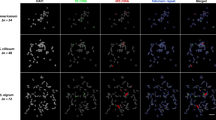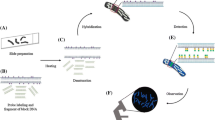Abstract
The Orchidaceae is one of the largest families of angiosperms, comprising more than 26,000 species in ca. 800 genera. Orchids species have relatively stable genomes with only 38 or 40 chromosomes, but individual phenotypes are extremely diverse. Since interspecific/intergeneric hybridization and polyploid production by artificial crossing are relatively easy, many cultivars have been bred to realize high commercial value in this group of plants. Such hybrids envisage genomic flexibility and intergenomic orientation. In order to elucidate the mechanisms of genomic flexibility, we have studied the genomes and epigenome marks of native Asian orchids, namely Vanda, Phalaenopsis, Cymbidium, and Dendrobium, using modern molecular cytogenetic techniques that facilitate physical visualization. Whereas, conventional meiotic analysis remains an important resource to understand genomic affinities based on chromosome pairing during meiosis, but the orchid taxa per se are not so well amenable for cytological observation, thus limiting the availability of information for genome analysis. Therefore, we developed a multi-color GISH method that can visualize genomes and reveal genome-donor species and hybridization history in artificial hybrids. We also focused our studies on epigenetic changes in the genome to elucidate the factors responsible thereof. The findings presented here provide information on physical visualization of genome(s), chromosomal distribution patterns of chromatin modifications with special emphasis on histone methylation, acetylation, phosphorylation, and centromere-specific histone marks in orchids using immuno-FISH. The novel findings emanating from this study are: (i) the dual modified histone H3S10phK14ac, which targets the peri-centromeric position of chromosomes may serve as a novel cytological marker to centromere, (ii) there is differential response to chromosomal DNA methylation among species and ploidy variants as discerned from 5mC distribution; larger chromosome size and elevated ploidy level exhibit enhanced methylation, (iii) in artificial intergenomic hybrids, genomes with large chromosomes and chromosomes located in the periphery of the nucleus tend to have more 5mC epigenetic changes, (iv) when identified in GISH experiments, the larger chromosome genome was found to exhibit more similarity to hybrid phenotypes. It is underpinned that to understand the flexibility of orchid genomes, it is important to grasp the entire genome through visualization techniques rather than fragmentary information at the molecular or cellular level.
Graphical abstract















Similar content being viewed by others
References
Alger EI, Edger PP. One subgenome to rule them all: underlying mechanisms of subgenome dominance. Curr Opinion Plant Biol. 2020;54:108–13. https://doi.org/10.1016/j.pbi.2020.03.004.
Begum R, Alam SS, Menzel G, Schmidt T. Comparative molecular cytogenetics of major repetitive sequence families of three Dendrobium species (Orchidaceae) from Bangladesh. Ann Bot. 2009;104:863–72.
Cai J, Liu X, Vanneste K, et al. The genome sequence of the orchid Phalaenopsis equestris. Nat Genet. 2015;47:65–72. https://doi.org/10.1038/ng.3149.
Chao YT, Chen WC, Chen CY, Ho HY, Yeh CH, Kuo YT, Su CL, Yen SH, Hsueh HY, Yeh JH, Hsu HL, Tsai YH, Kuo TY, Chang SB, Chen KY, Shih MC. Chromosome-level assembly, genetic and physical mapping of Phalaenopsis aphrodite genome provides new insights into species adaptation and resources for orchid breeding. Plant Biotechnol J. 2018;16:2027–41.
De Paula CMP, Souza Sobrinho F, Techio VH. Chromosomal distribution of H3K4me2, H3K9me2 and 5-methylcytosine: variations associated with polyploidy and hybridization in Brachiaria (Poaceae). Plant Cell Rep. 2016;35:1359–69.
Fuchs J, Demidov D, Houben A, Schubert I. Chromosomal histone modification patterns-From conservation to diversity. Trends Plant Sci. 2006;11:199–208.
Fuchs J, Jovtchev G, Schubert I. The chromosomal distribution of histone methylation marks in gymnosperms differs from that of angiosperms. Chromosome Res. 2008;16:891–8.
Hsu CC, Chung YL, Chen TC, Lee YL, Kuo YT, Tsai WC, Hsiao YY, Chen YW, Wu WL, Chen HH. An overview of the Phalaenopsis orchid genome through BAC end sequence analysis. BMC Plant Biol. 2011;11:3. https://doi.org/10.1186/1471-2229-11-3.
Houben A, Demidov D, Gernand D, Meister A, Leach CR, Schubert I. Methylation of histone H3 in euchromatin of plant chromosomes depends on basic nuclear DNA content. Plant J. 2003;33:967–73.
Ichihashi S, Ito H, Oguri T, Kato J. Investigation on ploidy of Cymbidium and Dendrobium cultivated in Japan using flow cytometer. Bulletin Aichi Univ Education. 2001;50:39–45.
Kuo YT, Hsu HL, Yeh CH, Chang SB. Application of a modified drop method for high-resolution pachytene chromosome spreads in two Phalaenopsis species. Mol Cytogenet. 2016;9:44. https://doi.org/10.1186/s13039-016-0254-8.
Kuo YT, Chao YT, Chen WC, Shih MC, Chang SB. Segmental and tandem chromosome duplications led to divergent evolution of the chalcone synthase gene family in Phalaenopsis orchids. Ann Bot. 2019;123:69–77.
Lavania UC, Srivastava S, Lavania S, Basu S, Misra NK, MukaiY,. Autopolyploidy differentially influences body size in plants, but facilitates enhanced accumulation of secondary metabolites, causing increased cytosine methylation. Plant J. 2012;71:539.
Lee YI, Chang FC, Chung MC. Chromosome pairing affinities in interspecific hybrids reflect phylogenetic distances among lady’s slipper orchids (Paphiopedilum). Ann Bot. 2011;108:113–21.
Lee YI, Chang FC, Chung MC. Distinct distribution patterns of 45S rDNA and 5S rDNA-NTS-related repeats display diverse karyotypes in Paphiopedium. In: Chen WH, Chen HH, editors. Orchid biotechnology III. New Jersey: World Scientific Publishing; 2016. p. 23–50.
Lee YI, Yap JW, ShairulIzan S, Leitch IJ, Fay MF, Lee YC, Hidalgo O, Dodsworth S, Smulders MJM, Gravendee B, Leitch AR. Satellite DNA in Paphiopedilum subgenus Parvisepalum as revealed by high-throughput sequencing and fluorescent in situ hybridization. BMC Genomics. 2018;19:578–91.
Leitch AR, Ma L, Dodsworth S, Fuchs J, Houben A, Leitch IJ. The role of chromatin modifications in the evolution of giant plant genomes. Plants. 2023;12:2159. https://doi.org/10.3390/plants12112159.
Matsuba A, Fujii M, Lee SS, Suzuki G, Yamamoto M, Mukai Y. Molecular cytogenetic use of BAC clones in Neofinetia falcata and Rhynchostylis coelestis. Nucleus. 2015;58:207–10. https://doi.org/10.1007/s13237-015-0147-y.
Mukai Y, Nakahara Y, Yamamoto M. Simultaneous discrimination of the three genomes in hexaploid wheat by multicolor fluorescence in situ hybridization using total genomic and highly repeated DNA probes. Genome. 1993;36:489–94.
Mukai Y, Sharma SK. Chromosome Calendar (2023) February Eds. Matsubara K, Uno Y. The Society of Chromosome Research, Japan. 2022
Sevilleno SS, Cabahug-Braza RA, An HR, Lim KB, Hwang YJ. The role of cytogenetic tools in orchid breeding. Korean J Agricul Sci. 2023;50:193–206. https://doi.org/10.7744/kjoas.20230015.
Sharma SK, Dkhar J, Kumaria S, Tandon P, Rao SR. Assessment of phylogenetic inter-relationships in the genus Cymbidium (Orchidaceae) based on internal transcribed spacer region of rDNA. Gene. 2012;495:10–5.
Sharma SK, Yamamoto M, Mukai Y. Immunocytogenetic manifestation of epigenetic chromatin modification marks in plants. Planta. 2015;241:291–301.
Sharma SK, Mukai Y. Chromosome research in orchids: current status and future prospects with special emphasis from molecular and epigenetic perspective. Nucleus. 2015;58:173–84.
Sharma SK, Yamamoto M, Mukai Y. Distinct chromatin environment associated with phosphorylated H3S10 histone during pollen mitosis I in orchids. Protoplasma. 2016;254:161–5. https://doi.org/10.1007/s00709-015-0925-z.
Sharma SK, Yamamoto M, Mukai Y. Dual modified antiphospho (Ser10)-acetyl (Lys14)-histone H3 predominantly mark the pericentromeric chromatin during mitosis in monokinetic plants. J Genet. 2016;95:965–73. https://doi.org/10.1007/s12041-016-0723-1.
Sharma SK, Yamamoto M, Mukai Y. Delineation of methylation and histone modification: the epigenetic regulatory marks show slightly altered distribution with the elevation in ploidy level in the orchid Dendrobium nobile. Nucleus. 2018;61:183–93.
Song C, Wang Y, Manzoor MA, Mao D, Wei P, Cao Y, Zhu F. Indepth analysis of genomes and functional genomics of orchid using cutting-edge high-throughput sequencing. Front Plant Sci. 2022;13:1018029. https://doi.org/10.3389/fpls.2022.1018029.
Suzuki G, Shiomi M, Morihana S, Yamamoto M, Mukai Y. DNA methylation and histone modification in onion chromosomes. Genes Genet Syst. 2010;85:377–82.
Verhoeven KJF, Jansen JJ, van Dijk PJ, Biere A. Stress induced DNA methylation changes and their heritability in asexual dandelions. New Phytol. 2010;185:1108–18.
Vilcherrez-Atoche JA, Iiyama CM, Cardoso JC. Polyploidization in orchids: from cellular changes to breeding applications. Plants. 2022;11:1–21. https://doi.org/10.3390/plants11040469.
Vimala Y, Lavania UC. Genomic territories in inter-genomic hybrids: the winners and losers with hybrid fixation. Nucleus. 2021;64:1–6. https://doi.org/10.1007/s13237-021-00348-1.
Yamamoto M. Molecular cytogenetic and epigenetic components of crossing barriers and peculiar reproduction ability in Allium hybrids. Nucleus. 2015;58:165–72. https://doi.org/10.1007/s13237-015-0153-0.
Acknowledgements
Sincere thanks are also due to Dr. SK Sharma, Dr. Go Suzuki, and all students of Plant Molecular Genetics Laboratory, OsakaKyoiku University, Osaka, Japan who were involved during the orchid project from 2010 to 2015, for their constant help and support. Figs. 9 and 14 reproduced in this article are from authors own publication, for which they hold author copyright.
Funding
This work was supported in part by Grants-in-Aidfor Scientific Research (C) (No. 22580004 to YM) from the JapanSociety for Promotion of Science (JSPS), Japan.
Author information
Authors and Affiliations
Contributions
YM conceived the idea, MY and YM contributed in planning/execution of research, and writing of the manuscript. Both the authorrs have read and consented to publish.
Corresponding author
Ethics declarations
Conflict of interest
Authors declare that there is no conflict of interest, including scienctific and commercial.
Additional information
Publisher's Note
Springer Nature remains neutral with regard to jurisdictional claims in published maps and institutional affiliations.
Corresponding Editor: Sachin Rustgi; Reviewers: Umesh C. Lavania, Manoj Lekhak, Ahmet L. Tek.
Rights and permissions
Springer Nature or its licensor (e.g. a society or other partner) holds exclusive rights to this article under a publishing agreement with the author(s) or other rightsholder(s); author self-archiving of the accepted manuscript version of this article is solely governed by the terms of such publishing agreement and applicable law.
About this article
Cite this article
Yamamoto, M., Mukai, Y. Physical mapping of genome and epigenome marks of orchidaceous plants using visualization technology: understanding genomic orientation and implications. Nucleus 66, 289–304 (2023). https://doi.org/10.1007/s13237-023-00448-0
Received:
Accepted:
Published:
Issue Date:
DOI: https://doi.org/10.1007/s13237-023-00448-0




